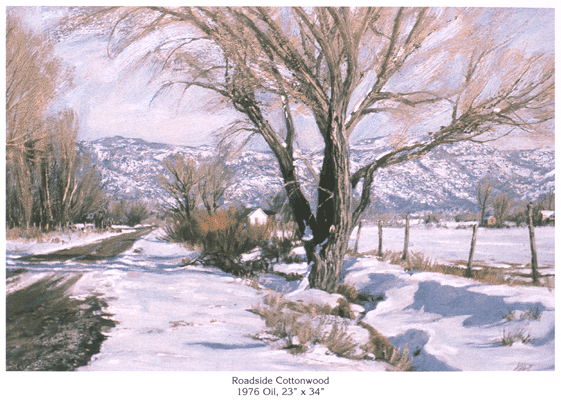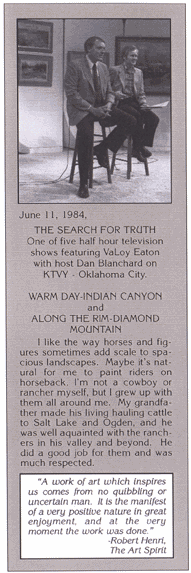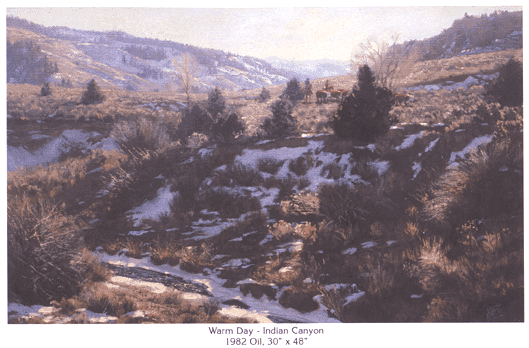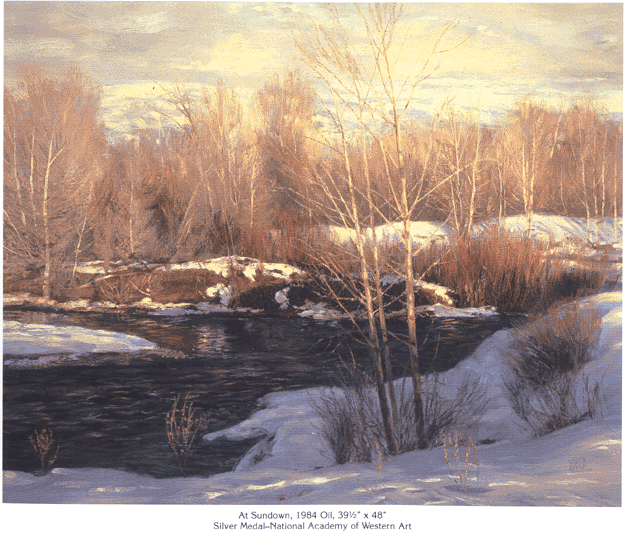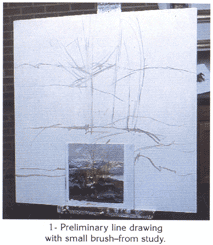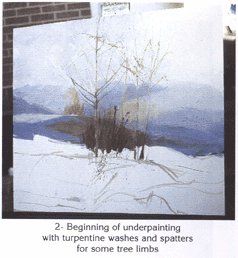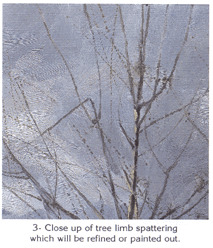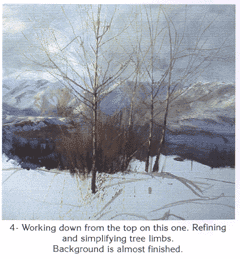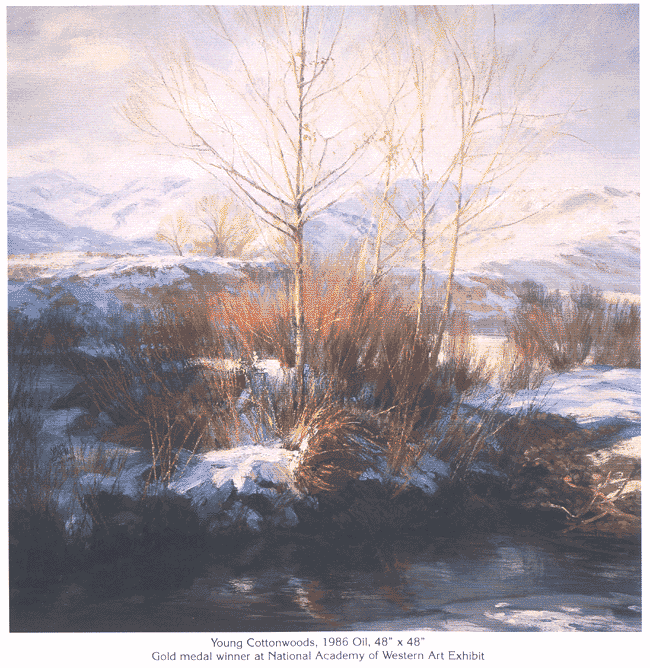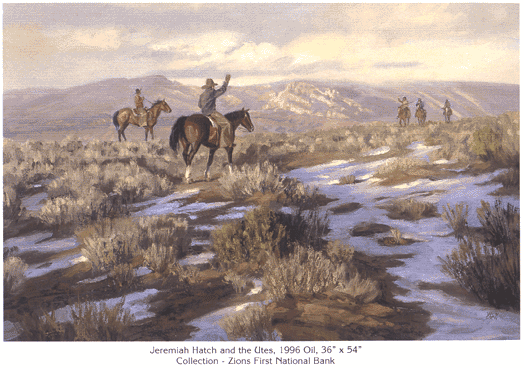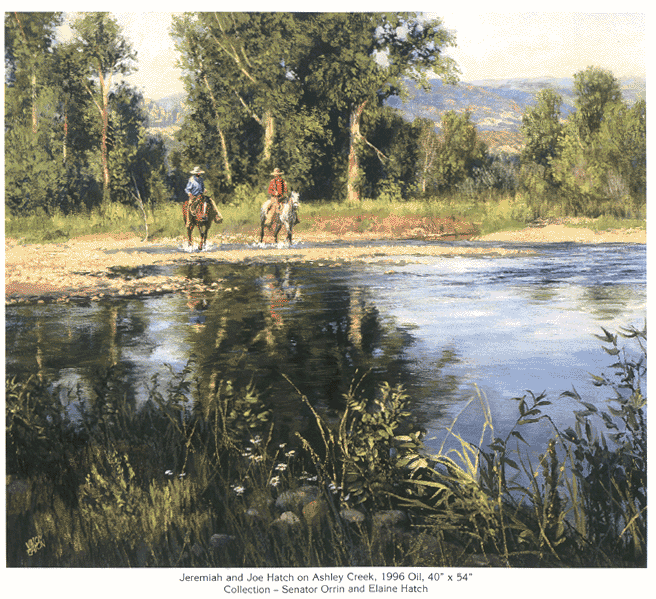 |
Forword By Senator Orrin G. Hatch
Valoy Eaton's incredible body of work - the deep brush lines, the marvelous
use of light, the bright colors and hues, the impressive landscape vistas,
and every so often the inspired use of children and women, neighbors,
friends, and loved ones - all evoke a special beauty that celebrates America
at its best.
I call the Eaton paintings "realistic impressionism." There is an impressionistic
quality to Valoy's work that evokes an image few will ever forget. His
rich palette and his genius use of hallmark themes-landscapes, hollyhocks,
streams, luscious sage brush, horses, farm animals, birds, rivers, and
mountains-all are so magnificent they render words insufficient to describe
their luminous beauty.
And of course, Valoy is a master of light. His magical depiction of light
dancing across mountains, trees, shrubs, rivers, streams, snow vistas,
and pioneer scenes is not easily forgotten. To view Valoy's paintings
gives one a perspective of just how much he loves the west and the beauties
of nature. He has a genius for finding just the right kind of lighting
and scenery. Whether it is a landscape of the shallow pastoral Susquehanna
River in Northern Pennsylvania, a portrait of my wife, Elaine, picking
raspberries in the garden, or a painting of cattle on the range being
herded by cowboys, the observer experiences a feeling of joy and peace
at the same time. Valoy is a person who looks at life and responds. He
has a pure appreciation of people and light.
It is for these reasons that I probably own more Valoy Eaton paintings
than anyone alive, including Valoy and Ellie Eaton, his wife. I started
collecting them when Valoy was teaching art and coaching basketball in
high school. I have followed his and Ellie's careers for many years and
have reveled in the acclaim he has achieved by other collectors, museums,
art contests, including the Cowboy Hall of Fame, by various collectors,
and by those who love fine art and recognize Valoy's special genius.
Valoy's pioneer paintings are already classics. They show the vibrancy
of the early builders of our nation, particularly the west. As we gaze,
with appreciation, one can almost imagine the strength, courage, fortitude,
faith, and decency of the pioneers who settled the west. His huge painting
of my great grandfather, Jeremiah Hatch, and his son Josephus, my grandfather,
crossing over Ashley Creek (pg. 97), hangs in my Senate office in the
Hart building directly over my desk. Leaders from all over the world have
mentioned how truly remarkable it is.
One of my favorite paintings is the one he painted for me of five old
overall-dressed ranchers standing there with the backsides of their four
horses showing (pg. 31). It is American classic. I call it the "Five Republicans
and four Democrats." It is a small, but significant painting. Virtually
everyone who visits my Salt Lake City office loves it.
Valoy's paintings are in great demand. He still takes commissions, but
loves to do his own subjects and themes while roaming over our country's
beautiful and spectacular terrain. He ranks among the finest artists of
our time and, I believe, his work will be accepted as magnificent for
centuries to come.
Talents like Valoy's point us to the existence of God and his work. And
only God could have inspired and magnified his earthly talent enabling
him to create some of the most beautiful landscapes ever created. This
book is the first opportunity for many to become familiar with his outstanding
work, and also to gaze on a special collection of some of his most beautiful
and refined work-the artwork (25 precious and august paintings) he voluntarily
painted and gave to the Church of Jesus Christ of Latter-day Saints for
its temples. Valoy is so respected, he was able to obtain special permission
to display, in this book, these magnificent paintings, which are not available
to the general public, because of their use in the sacred temples.
So today, we are all fortunate to have this amazing compilation of Valoy's
work. The joy Valoy's work has brought to my wife, Elaine, and me and
countless others is inexpressible, and I hope each of you will share in
that bounty as you savor the many riches he offers.
Orrin G. Hatch
U.S. Senator, State of Utah, 2002 |
 |
Introduction Page XXVii - By Vern G. Swanson, Ph.D Director, Springville Museum of Art
back to top
|
charity auctions and fund-raisers. He has also volunteered to be the coach of youth baseball and basketball
teams throughout the years.
A great honor was bestowed in the early 1980s, when the Granite School District
began to make an annual art award called "The VaLoy Eaton Scholarship." He had taught in the Granite District for
ten years and left a lasting impression. Then, in the 1990s, Zions Bank in Vernal began giving the Eaton Art
Scholarship for Uintah High, where he received the "Distinguished Alumnus Award." His portrait now hangs in the
school alongside other honorees.35
An article on VaLoy appeared in 1981 in Southwest Art magazine. Eaton asked Vern
Swanson to write it because, as he said humorously, "You're the only person I know who understands art, who likes
my paintings!" This was not exactly true, but it was flattering to Swanson, who went on to write another six
articles on different artists for Southwest Art. The magazine article was followed by a large retrospective
exhibition at the Springville Museum of Art in October 1982. The show, which was cosponsored by Senator Orrin and
Elaine Hatch, included seventy-three carefully selected paintings.
Reviewing the exhibition, George Dibble, art editor for the Salt Lake Tribune, pronounced
VaLoy Eaton to be the best landscapist now working in the state. This watershed exhibition at the artist's mid-career
was a period of personal reassessment. It strengthened his determination not to "potboil" or paint "second, third or
fourth variants" of his best work.
He resolved to keep pushing for original, strong, and sensitive visual statements in each piece he painted. The vigor
of Eaton's work during the last score of years was based on the decision in 1982 to please his own internal
|
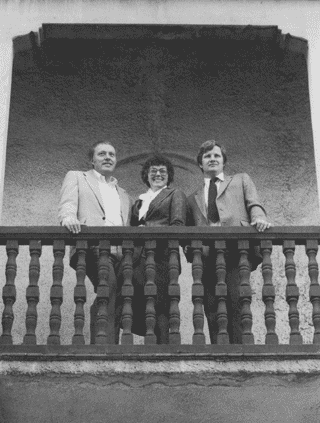
VaLoy, Ellie, and Vern
at the Springville Museum of Art, 1982
|
|









